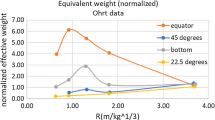Abstract
Comparisons of explosives are often carried out using TNT equivalency which is based on data for spherical charges, despite the fact that many explosive charges are not spherical in shape, but cylindrical. Previous work has shown that it is possible to predict the over pressure and impulse from the curved surface of cylindrical charges using simple empirical formulae for the case when the length-to-diameter (L/D) ratio is greater or equal to 2/1. In this paper, by examining data for all length-to-diameter ratios, it is shown that it is possible to predict the peak over pressure, P, for any length-to-diameter ratio from the curved side of a bare cylindrical charge of explosive using the equation \(P=K_PM(L/D)^{1/3}/R^3\), where M is the mass of explosive, R the distance from the charge and \( K_P\) is an explosive-dependent constant. Further out where the cylindrical blast wave ‘heals’ into a spherical one, the more complex equation \(P=C_1(Z^{\prime \prime })^{-3}+C_2(Z^{\prime \prime })^{-2}+C_3(Z^{\prime \prime })^{-1}\) gives a better fit to experimental data, where \( Z^{\prime \prime } = M^{1/3}(L/D)^{1/9}/D\) and \(C_1,\, C_2 \) and \( C_3\) are explosive-dependent constants. The impulse is found to be independent of the L/D ratio.









Similar content being viewed by others
References
Stoner, R.G., Bleakney, W.: The attenuation of spherical shock waves in air. J. Appl. Phys. 1948(19), 670–678 (1948)
Cole, R.H.: Underwater explosions. Princeton University Press, New Jersey (1948)
Victor, A.C.: Warhead Performance Calculations for threat Hazard Assessment. Department of Defense Explosives Safety Seminar, Las Vegas (1996)
Knock, C., Davies, N.: Predicting the peak pressure from the curved surface of detonating cylindrical charges. Prop. Expl. Pyro. 36(3), 203–209 (2011)
Knock, C., Davies, N.: Predicting the impulse from the curved surface of detonating cylindrical charges. Prop. Expl. Pyro. 36(2), 105–109 (2011)
Swisdak M.M.: Explosion effects and Properties, Part 1- Explosion effects in air, Report NSWC/WOL/TR 75-116, Naval surface Weapons Report, White Oak, Silver, Spring, Maryland 20910 (1975)
Wisotski J., Snyer W.H.: Characteristics of blast waves obtained from cylindrical high explosive charges. Report, University of Denver, Denver Research Institute, Denver, Colarado 80210 (1965)
Plooster M.N.: Blast effects from cylindrical explosive charges: Experimental measurements. Report NWC TP 6382. Naval Report Centre, China Lake, California 93555 (1982)
Brode, H.L.: Numerical solutions of blast waves. J. Appl. Phys. 26(6), 766–775 (1955)
Pechoux F., Simeons B., Lefebrve M.H.: TNT-Equivalent and explosive charge characteristics. 10eme Congres International de Pyrotechnic du Groupe de Travail de Pyrotechnie, Reims, pp. 592–597 (2011)
Hammond L.: Underwater shock wave characteristics of cylindrical charges. Report DSTO-GD-0029, Aeronautical and maritime research Laboratory, ship structures and materials division. Quoting Rice and Gimmel (1944) reference not given (1995)
JMEM the Joint Munitions Effectiveness Manual, Report USAF -61A1-3-7; NAVY NAVAIR 00–130-ASR-2-1; USMC FMFM 5–21; ARMY FM 101–51-3. Revision 2 (1989)
Plooster M.N.: Blast front pressures from cylindrical charges of high explosives. Report NWC-TM-3631. Denver Research Institute, Naval Weapons Center, China Lake, California, 93555 (1978)
Sachs R.G.: The dependence of blast on ambient pressure and temperature. BRL report 466, Aberdeen Proving Ground, Maryland (1944)
Fundamentals of protective design for conventional weapons, Report TM 5–855-1, US Army. Also known as Air force pamphlet AFPAM 32–1147 (I) and Navy manual NAVFAC (Naval facilities P-1080) and DSWA manual DAHSCWEMAN-97 (1986)
Wharton, R.K., Formby, S.A., Merrifield, R.: Airblast TNT equivalence for a range of commerical explosives. J. Hazard. Mater. A79, 31–39 (2000)
Maienschein, J.L.: Estimating equivalence of explosives through a thermochemical approach. Lawrence Livermore National Lab. URCL-JC-147683 (2002)
Locking P.M.: The trouble with TNT equivalence. Ballistics 2011, 26th International symposium on ballistics Publ. Vol 1–2, pp. 143–154. Destech Publications Inc, Lancaster, PA (2011)
Lindburg H.E., Firth, R.D.: Structural response of pine vehicles. Vol II simulation of transient surface loads by explosive blast waves. Stanford research Institute, Menlo Park, California. Technical Report AFWL-TR-66-163 Vol II (1967)
Acknowledgments
Part of this work was funded by the Defence Academy—College of Management and Technology, UK.
Author information
Authors and Affiliations
Corresponding author
Additional information
Communicated by K. Hayashi and K. Kontis.
The paper was based on work that was presented at the 28th International Symposium on Shock Waves, 17–22 July, 2011, Manchester, UK.
Rights and permissions
About this article
Cite this article
Knock, C., Davies, N. Blast waves from cylindrical charges. Shock Waves 23, 337–343 (2013). https://doi.org/10.1007/s00193-013-0438-7
Received:
Revised:
Accepted:
Published:
Issue Date:
DOI: https://doi.org/10.1007/s00193-013-0438-7




